Beginning approximately 300 or 400 A.D., mango seeds spread over Asia, the Middle East, Africa, and South America. Commercial mango production in the United States dates back to the early 1900s, although it is still very much in its infancy. Mangos are only found in Florida, California, Hawaii, and Puerto Rico because they need a tropical environment to thrive. Let’s check out more information about mango farming in USA.
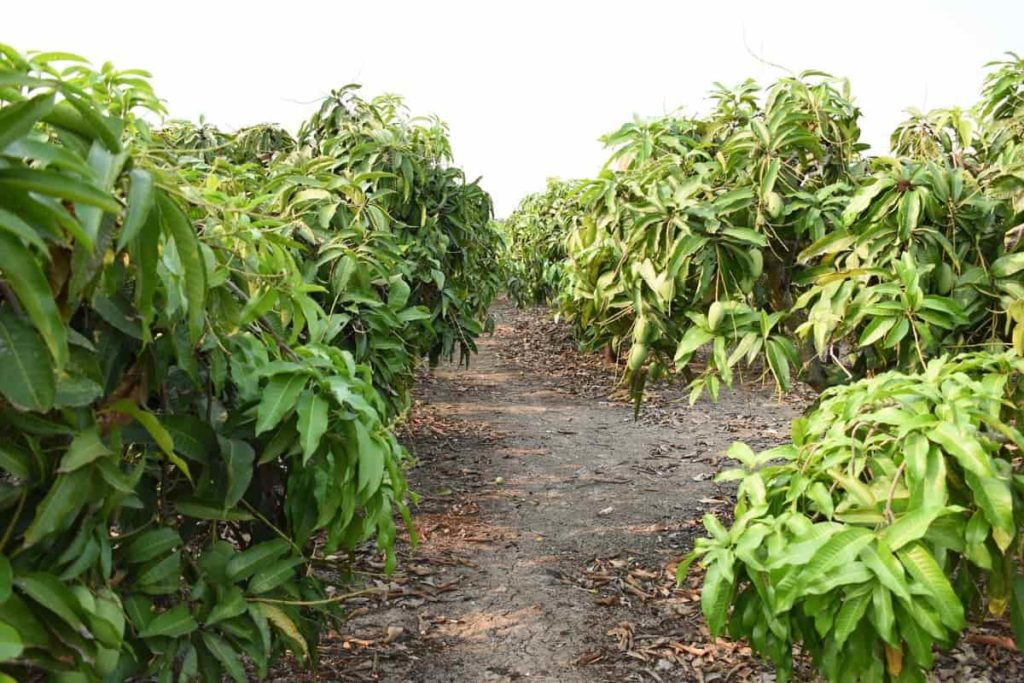
For the last 30 years, mangos have been grown commercially in Puerto Rico. About 4,000 acres of mangos are now being grown for export. However, most of this produce goes to Europe rather than the United States mainland. Farmers with property suitable for growing mangos hesitate to leave their tried-and-true crops like grapes and oranges.
Mangos are expected to occupy around 300 acres in Hawaii, virtually all of it being marketed in the state. This article discusses mango cultivation in the USA and when and where you can grow mangoes in the USA. We hope this article will be your mango plantation guide for cultivating mangoes in a large area.
USDA hardiness zones in which you can grow mango trees
The only climates suitable for the growth of mango trees are tropical ones. The poor cold tolerance of mango trees might result in the tree’s death or significant damage if it is subjected to temperatures for an extended period that falls below 30 degrees Fahrenheit. Therefore, the southernmost parts of Florida, California, Hawaii, and Puerto Rico are the only areas in the United States suitable for cultivating mango trees.
Even though the mango tree’s cold tolerance isn’t one of its strong features, mangos are grown worldwide in mango tree growth zones. Americans can enjoy the wonderful fruit throughout the year, even if mango trees don’t do well in colder climates.
Growing mangoes in USDA hardiness zone 9B
Without significant supplemental care, mangoes in the United States cannot endure growing conditions in zones with numbers lower than 9B. In this part of the nation, the temperature does not usually drop below 25 degrees Fahrenheit, and it may not even do so in some years. Mangoes can tolerate temperatures as low as 26 degrees Fahrenheit, although this only applies to mature trees.
Temperatures below freezing pose a threat to young trees. Central Florida, the southern end of Texas, and areas of the Southwest often fall within the purview of Zone 9B. Zone 9B is usually an excellent place to grow mangoes, although they may need extra warmth, such as a blanket or a light if the evenings are chilly.
Growing mangoes in USDA Hardiness Zone 10
Mango trees have an easier time surviving in zones with higher numbers assigned by the USDA. Mangoes can be grown well in Zone 10, both A and B, and, with a few notable exceptions, they are not at risk of being harmed there unless unusual conditions occur. This is often the location outdoors where one will find the trees most of the time.
South Florida and Southwest California are examples of regions inside Zone 10. Mangoes are generally abundant in both of these regions. In addition, a tiny commercial mango growing region in South Florida, roughly 650 hectares.
In case you missed it: Top 14 Steps to Boost Mango Fruit Yield: Methods, Yield Improving Tips, Fertilizer to Increase Fruit Size
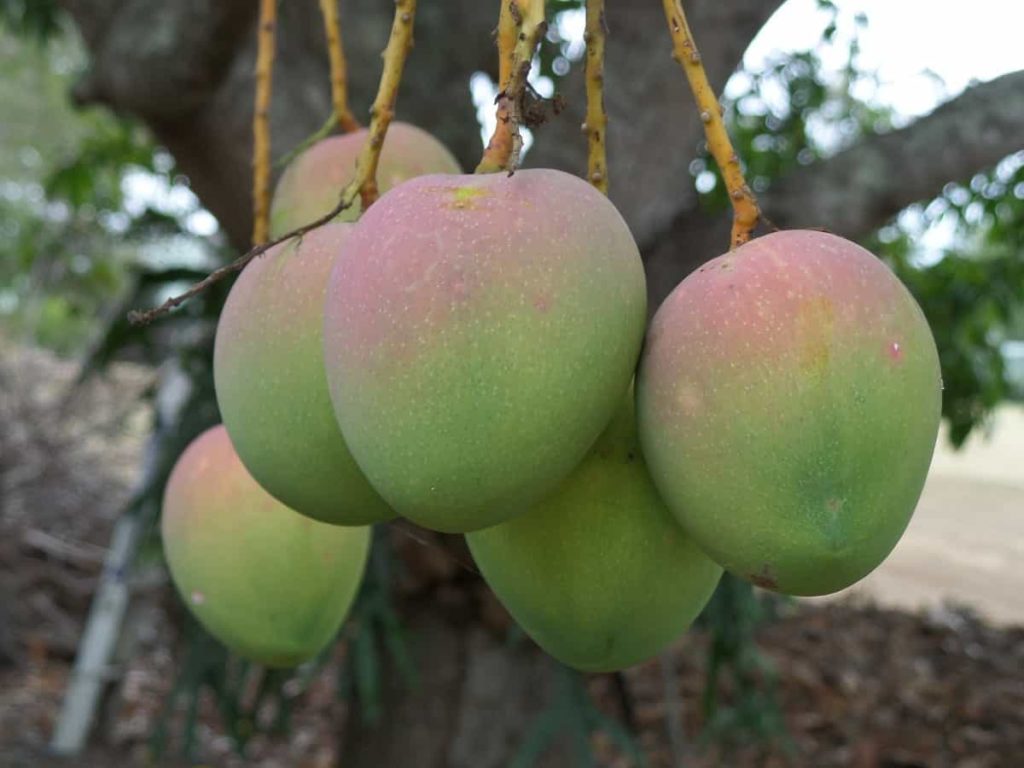
Growing mangoes in USDA Hardiness Zone 11
Mangoes can be cultivated safely only in Zone 11 in the United States. In this world, the temperature rarely falls below 40 degrees. Within the continental United States, there is not a single location that exhibits this phenomenon. Only sites in Hawaii make up Zone 11 of the zone. Zone 10 also includes a portion of Hawaii.
Different mango varieties that can be grown in the USA
Mangoes have been cultivated in the United States for over a century, although there is very little commercial or large-scale production of mangoes. Only California, Florida, Hawaii, some parts of Texas, and Puerto Rico can cultivate mangos since this fruit requires a tropical environment to thrive. Rapoza, Haden, and Pirie are examples of varieties that can only be found in Hawaii. Varieties cultivated in Florida include Carrie, Glenn, Haden, and Valencia Pride.
The growing season for mangoes in Florida typically runs from May through October, but July is considered the “peak” season for most varieties. As part of a seedling program established by the United States Department of Agriculture (USDA), several different mango types have been grown in South Florida. The program’s primary objective was to increase the number of mango types grown in the area to harvest more mangoes for export.
This effort in Florida is responsible for developing many of the popular kinds of mango that are produced all over the globe today. These varieties include the Haden, Tommy Atkins, Keitt, and Kent mangoes.
Mango farming in USA: Step-by-step guide for mango cultivation
Climatic requirements to grow mango trees in USA
Mango trees need a zone between zones 9 and 11 to thrive when cultivated outside of the United States. The ideal temperature range for the growth of mango trees is between 80 and 100 degrees Fahrenheit (26 and 38 degrees Celsius). It is thus recommended to cultivate mango plants outside in a very warm environment.
Freezing temperatures are fatal to mango trees. Above 50 degrees Fahrenheit (10 degrees Celsius) must be maintained as their core temperature. The tree’s flowers and fruit will be damaged below 10 degrees Celsius.
Soil requirements to cultivate mangoes
Mangoes need soil that is sandy, loose, and able to drain excess water quickly. First, check your soil pH to see whether or not it is within an appropriate range of acidity; the trees will thrive in soil with a pH ranging from 4.5 to 7 (acidic). To maintain a high level of acidity in your soil, work peat moss into the top layer of the ground annually.
You should avoid using any products that include salt or contain chemical fertilizers since doing so can slow down the development of your mango tree. Three feet of tilling will allow the roots to develop and spread out.
Choose a mango variety to cultivate in your area
Many mangoes are available for purchase, but only a few are suited to growing in certain regions. Go to a nursery near you to advise which plants will do well in your region’s soil. Mangoes can be cultivated in one of two ways: either from the seed of an existing mango or from a seedling that has been grafted onto another mango tree. It normally takes eight years for mango seeds to mature into fruit.
Grafted saplings require three to five years to yield fruit, but it is almost certain that the harvest will be successful. If you want to create your mango tree from a seed, choose one known to thrive in your region. Taking a seed from a mango you purchased at a shop is unlikely to result in the growth of a mango tree. Compared to a tree produced from seed, a grafted sapling will only reach around half the size.
In case you missed it: High Density Mango and Ultra High Density Plantation Per Acre, Yield In India
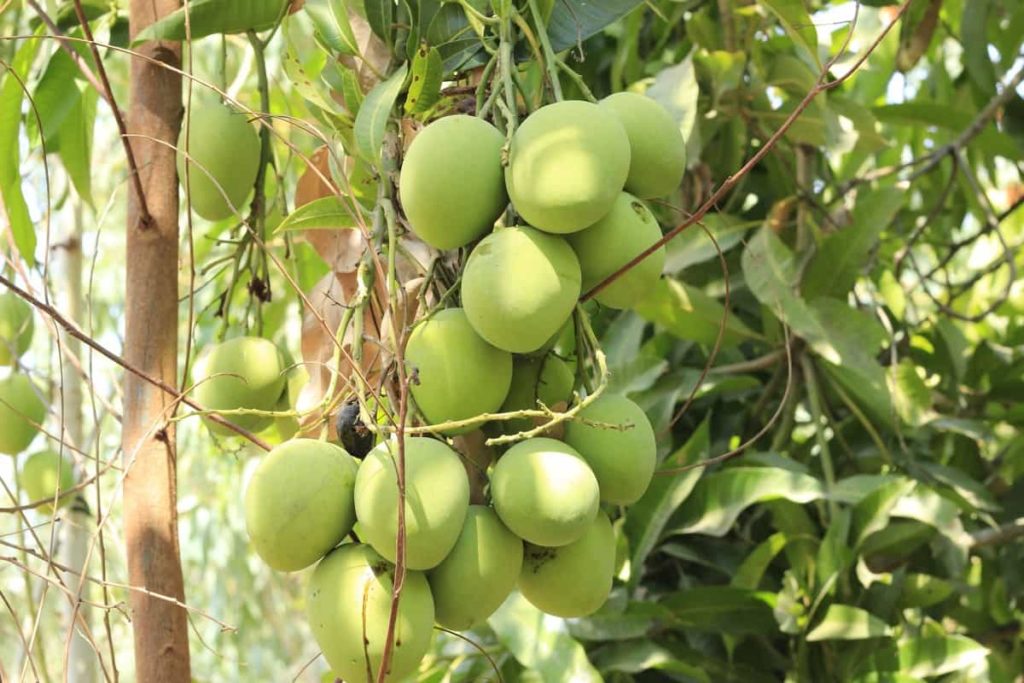
The trees grown from seeds are often considerably more robust and enduring, but it’s possible that they won’t be as trustworthy when it comes to fruit production. A few types of mango can thrive in settings that are a little more chilly and moist than recommended, so if you want to push the environmental boundaries of your mango cultivation, you have some options.
Propagation of mango trees
Propagation of Mangoes from seeds
The vitality of mango seeds is very short-lived. After removing the seed, the fruit must be washed. After that, it has to be left out in the sun for a few days to dry. Before planting, remove the husk. Make a tiny cut in the fruit’s husk near the stalk end to remove the embryo. Then, use a seed opening tool to pry open the husk. If you have circlip pliers, you can fuse two flat screwdriver heads.
Consider utilizing a seedling bed if you plan on propagating many seeds. This approach conserves floor area, potting media, and labor time. Plant the seeds roughly a millimeter apart from each other. The seeds are shaped like kidneys. Make sure the concave side of the seed is facing down before planting it. Leave a bit of the seed’s crown exposed. As soon as the seed becomes green, you can be certain it is healthy and will grow healthily.
Brown or black seeds indicate decomposition and should be removed for a fresh batch. The seeds can be gently plucked from the seedling bed as they germinate and are planted in separate locations throughout your yard. During 10 to 14 days, seed germination occurs. They’ll grow to a stem diameter of 8-10mm and a height of 10-15cm in around eight months.
Propagation of mangoes by grafting
Grafting mango trees, or other trees, involves attaching a mature, bearing scion to a rootstock. The scion becomes the tree’s canopy and rootstock, its trunk and roots. Grafting mango trees is the most dependable and cost-effective propagation technique. Kensington and common mango are good as rootstock; in South Florida, “Turpentine” is preferred. Grafting requires a robust rootstock. Size and age are unimportant as long as it’s healthy. The most stock should be 6-12 months old.
The seedling stem should be between 3/8 to 1 inch (1 to 2.5 cm) wide, green, rot- and disease-free, and have healthy leaves and buds. Cut the rootstock approximately 10 cm above the earth. Use sharp shears or a grafting knife. Level the cut and don’t harm the stem. Cut the remaining stem half from top to bottom, approximately one inch above the soil. You’ll need to look for a fresh-growth branch or scion on an established mango tree.
Thinner than the plucked rootstock, the scion should have new buds and leaves. Trim the top leaves from the 3 to 6-inch (7.5 to 15 cm) scion piece. To form a point on the end of the scion, split it in half with a knife and slice the bark away from either side. Insert scion wedge into rootstock slot. Ensure they line up.
Tape the rootstock and scion together. Tie a plastic bag around the new graft to create a warm, humid environment and protect it from insects. Remove the bags as the tree starts growing. Once the tree grows leaves, remove the tape. Don’t overwater after grafting.
Planting mango seedlings
The distance between mango trees varies according to the kind of mango and the growing climate (dry and wet zones). In dry zones, the recommended spacing is 10 meters by 10 meters, as there is not a lot of vegetative development there. On the other hand, in moist and rich soils, the recommended spacing is 12 meters by 12 meters, as there is a lot of vegetative growth there.
This is the ideal mango tree plantation distance according to the soil type present in the land. By this, you can estimate the mango plantation per acre or hectare. If possible, planting holes should be dug before the beginning of the rainy season so that water may gather in the hole during the rainy season, increasing the likelihood that the seedlings planted will survive. The holes should have a depth of one meter, a width of one meter, and a length of one meter each (1m x 1m x 1m).
The spacing of these holes has to consider both the canopy of the mango tree and the richness of the surrounding soil. Therefore, if you are prepared to plant, you should re-fill the planting holes with a quarter of the topsoil taken from the area surrounding the hole or remove the soil while preparing the holes. Then, when required, properly combine this soil with the prescribed quantities of farmyard manure or tree fertilizers at a ratio of 3:1, depending on which one you are using.
While keeping the seedling upright, rip the polythene bag or polythene tube open on one of the sides or at the bottom. On the other hand, if the seedling was grown in a tin or some other container, give it a little tap on the top of the container. Then, holding the seedling at the stem’s base, remove it from the tube. Ensure that the root systems are not disturbed while doing this.
Place the seedling into the hole, then cover it with the soil. Topsoil should be used to fill in about half of the hole, then pressed gently toward the root. Before filling the hole with soil, you should first fill it with water and then give it some time to drain. Ensure this is carried out without disturbing the soil surrounding the roots or twisting the roots.
In case you missed it: Mango Tree Grafting; Training; Pruning Techniques

Create a basin around the tree’s trunk by gently pressing the soil all around the seedling to create the basin. The water will be held in the basin for convenience following the watering. Ensure the seedling is positioned to sit erect, exactly as it was on the polythene tube at the nursery. Spread a layer of mulch under newly planted trees. The use of mulch supplies organic matter, and it also minimizes the amount of moisture lost and the amount of weed competition.
Sunlight requirements for mango trees
Mango trees that have reached maturity flourish in full sun. Your goal should be to expose them to at least 8-10 hours of sunshine each day. While they are still being established, new or immature mango tree seedlings could need shelter from direct sunlight.
Irrigation needed
To encourage healthy growth and establishment in the field, watering should begin as soon as the seeds have been planted. You should water your mango tree every eight to twelve days from when it produces flowers until maturity. This will help you achieve greater harvests.
It is not a good idea to water the plant two to three months before it is supposed to flower since doing so will stimulate the growth of more branches and leaves. Using a drip irrigation system is the most effective form of watering that you can use on your mango farm.
Fertilising requirements
You should add nitrogenous fertilizers three to six months after planting the seed. To prevent nitrogenous fertilizers from draining away, apply them at varying intervals. An additional option is to use mulching, farmyard manure or compost that has been properly prepared, ash from the kitchen, or kitchen waste in place of fertilizers. Make sure you use organic fertilizers for fertilizing requirements, as they can have a greater positive impact on plant growth and fruit yield.
Pruning requirements
It is necessary to control both the size and shape of the fruit tree. This is to direct the tree’s growth and make the gathering of its fruit easier in later phases. Pruning should begin in the first year to shape the tree into the desired form, and when the seedlings are approximately 1 m from the ground, cap the seedlings to stimulate side branches.
After the fruit has been harvested, it is the appropriate time to prune the tree since this is an important part of effective tree management. Maintain a height of around 3.5 meters and remove any lower branches than knee level (approximately 0.5 meters). Prune any dead branches from the tree’s canopy to enable sunlight to reach the ground below.
Harvesting
Depending on the variety, it might take 90 to 160 days following the flowering stage for the mangoes to reach full maturity. It is essential to have good harvesting procedures; mangos should not be plucked from the tree by beating them with a stick and then letting them fall to the ground. They must be plucked by hand, and it is preferable to collect them with a small amount of stem (2–3 centimeters) still connected to the fruit.
This decreases the latex that could cover the fruit if picked wrongly. The fruits are often harvested when their exterior color changes, such as when certain cultivars transition from dark green to lighter green. Pick the fruit by hand or cut it off using a long stick (the portion linking the fruit to the branch) approximately 2–3 centimeters in length. When transporting the fruit to the market, put the fruit in a layer with the stalks facing down in a box or crate.
In case you missed it: Mango Pests, Diseases, and Control Methods – a Full Guide
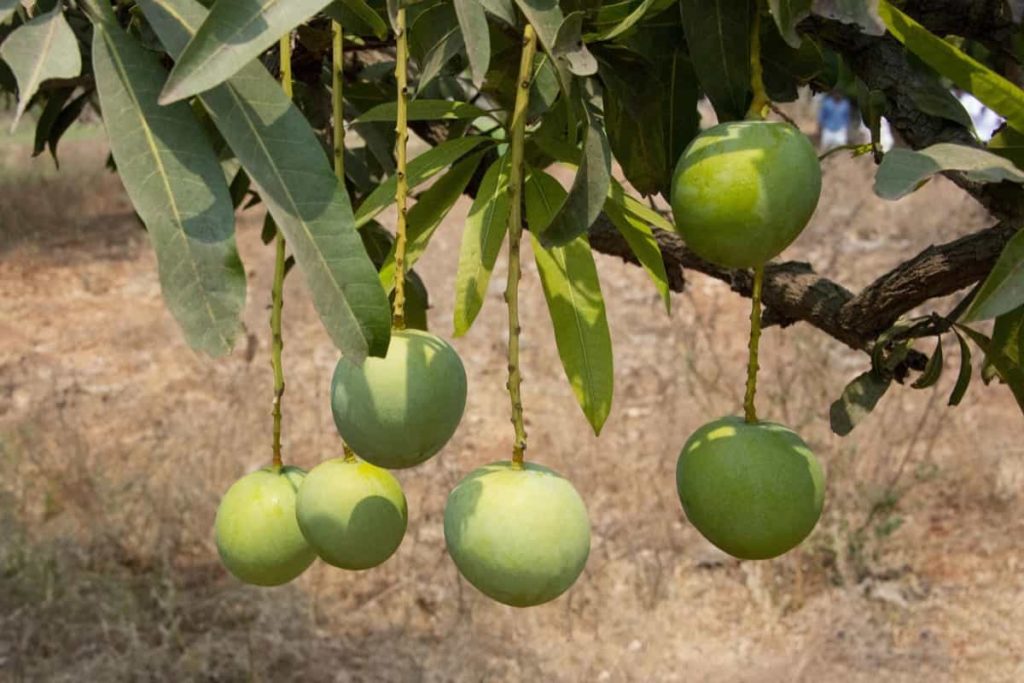
Pest and disease management
Anthrax
Anthrax is common. The disease damages young shoots, flowers, and fruits under high humidity, frequent rains, and 24-32 ˚C temperatures. It affects stored fruits. Symptoms are leaf spot, flower blight, wither tip, twig blight, and fruit rot. Young branches die from damage to tender shoots and leaves. Infected older twigs might be fatal. By applying proper organic fertilizers from the start, this can be prevented.
Blooming blight
Depending on the season, blossom blight can be mild to severe—panicle and fruit black spots. Severe infection kills the inflorescence, preventing fruiting. Infected young fruits shrivel and drop. Infected ripe fruit causes storage, transportation, and marketing losses. The fungus grows on mango twigs and leaves. To reduce inoculum potential, diseased twigs should be trimmed and burned with falling leaves.
Sooty mold
The disease is regular if the orchards are not properly managed. Detection of the disease in the field is made possible by a black velvety covering. As a result of fungus covering all branches and leaves, trees might become black in extreme situations. The honeydew secretions of insects stick to the leaf surface and serve as a nutrient-rich environment for fungi.
Due to its lack of need on host tissues for nutrition, this fungus is considered non-pathogenic. Stomatal obstruction reduces the leaf’s photosynthetic activity even if the fungus itself does not do any harm. Pruning and destroying diseased branches stop the disease from spreading. Spraying with 2% starch is effective, according to the research.
In case you missed it: Organic Mango Farming, Cultivation Practices
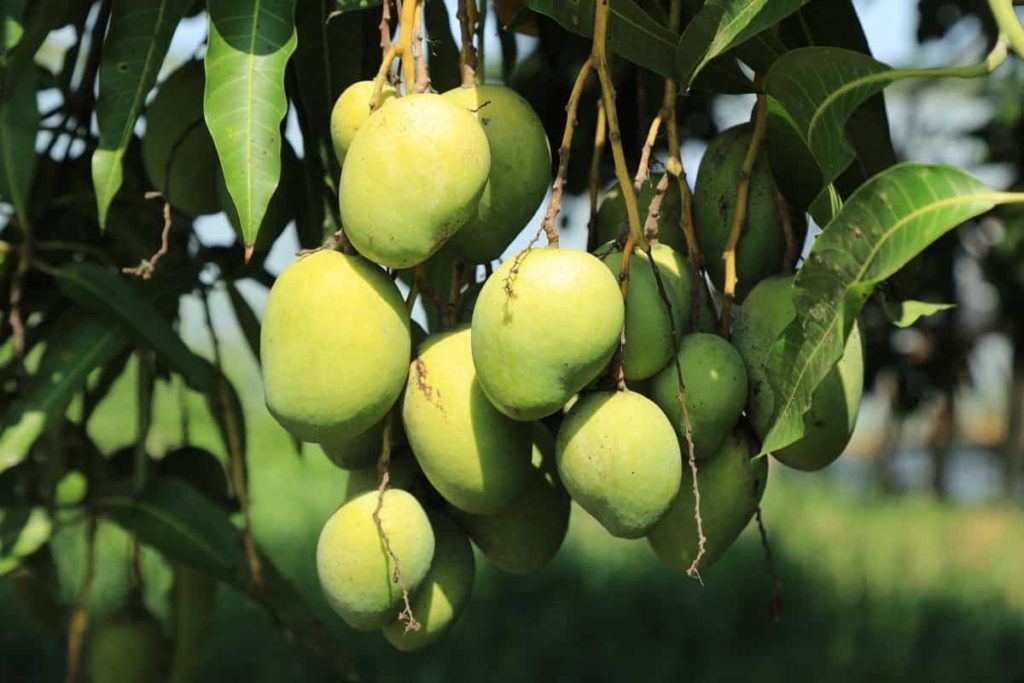
Pests
Mango trees are infested by 492 insects, 17 different kinds of mites, and 26 different kinds of nematodes. The crop has been severely damaged by over a dozen of these pests, and as a result, they can be considered serious pests of mango.
Mealybugs, inflorescence midges, hoppers, scale insects, shoot borers, fruit flies, leaf Webber, and stone weevils are common pests. Flowering and fruiting crop stages are most vulnerable to pest infestations. Using proper organic pesticides and insecticides from the start can help prevent the attacks of such pests.
Conclusion
Mango farming in the United States is an excellent, profitable farming business idea for people who want to enter the horticulture sector.
- Economical Aquaculture: A Guide to Low-Budget Fish Farming
- 15 Common Planting Errors That Can Doom Your Fruit Trees
- How to Make Houseplants Bushy: Effective Tips and Ideas
- Innovative Strategies for Boosting Coconut Pollination and Yield
- Pollination Strategies for Maximum Pumpkin Yield
- The Complete Guide to Chicken Fattening: Strategies for Maximum Growth
- Natural Solutions for Tulip Problems: 100% Effective Remedies for Leaf and Bulb-Related Issues
- Revolutionizing Citrus Preservation: Towards a Healthier, Greener Future
- Natural Solutions for Peony Leaf and Flower Problems: 100% Effective Remedies
- Maximizing Profits with Avocado Contract Farming in India: A Comprehensive Guide
- Natural Solutions for Hydrangea Problems: 100% Effective Remedies for Leaf and Flowers
- The Ultimate Guide to Choosing the Perfect Foliage Friend: Bringing Life Indoors
- From Sunlight to Sustainability: 15 Ways to Use Solar Technology in Agriculture
- The Ultimate Guide to Dong Tao Chicken: Exploring from History to Raising
- The Eco-Friendly Makeover: How to Convert Your Unused Swimming Pool into a Fish Pond
- Mastering the Art of Delaware Chicken Farming: Essentials for Healthy Backyard Flocks
- 20 Best Homemade Fertilizers for Money Plant: DIY Recipes and Application Methods
- How to Craft a Comprehensive Free-Range Chicken Farming Business Plan
- Brighten Your Flock: Raising Easter Egger Chickens for Beauty and Bounty
- How to Optimize Your Poultry Egg Farm Business Plan with These Strategies
- Subsidy for Spirulina Cultivation: How Indian Government Schemes Encouraging Spirulina Farmers
- Ultimate Guide to Raising Dominique Chickens: Breeding, Feeding, Egg-Production, and Care
- Mastering the Art of Raising Jersey Giant Chickens: Care, Feeding, and More
- Ultimate Guide to Raising Legbar Chickens: Breeding, Farming Practices, Diet, Egg-Production
- How to Raise Welsummer Chickens: A Comprehensive Guide for Beginners
- How to Protect Indoor Plants in Winter: A Comprehensive Guide
- Ultimate Guide to Grow Bag Gardening: Tips, Tricks, and Planting Ideas for Urban Gardeners
- Guide to Lotus Cultivation: How to Propagate, Plant, Grow, Care, Cost, and Profit
- Agriculture Drone Subsidy Scheme: Government Kisan Subsidy, License, and How to Apply Online
- Ultimate Guide to Raising Araucana Chickens: Breed Profile, Farming Economics, Diet, and Care
- Bringing Hydroponics to Classroom: Importance, Benefits of Learning for School Students
- Ultimate Guide to Raising Polish Chickens: Breed Profile, Farming Economics, Diet, and Care
- Ultimate Guide to Raising Australorp Chickens: Profile, Farming Economics, Egg Production, Diet, and Care
- Silkie Chicken Farming: Raising Practices, Varieties, Egg Production, Diet, and Care
- Sussex Chicken Farming: Raising Practices, Varieties, Egg Production, Diet and Care
- Homemade Feed Formulations for Livestock: Discover Cost-effective Starter to Finisher Feed Recipes
Thanks for the info